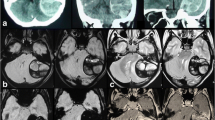Abstract
Background
The cavernous sinus, which has several important structures, can be affected by various lesions, including tumor, vascular, infection, and inflammation.
Case report
We reported a rare case of abscess of the cavernous sinus in a child presenting with headache and abducens paralysis. Exploratory surgery was performed via the Dolenc approach, and the patient recovered from abducens paralysis 3 months later.
Conclusion
Abscess of the cavernous sinus is rare. Inspection of cavernous sinus can confirm the characteristics of the lesion and decompress the cavernous sinus, which may be beneficial for nerve function recovery.



Similar content being viewed by others
References
Bhatkar S, Goyal MK, Takkar A, Mukherjee KK, Singh P, Singh R, Lal V (2017) Cavernous sinus syndrome: a prospective study of 73 cases at a tertiary care centre in Northern India. Clin Neurol Neurosurg 155:63–69. https://doi.org/10.1016/j.clineuro.2017.02.017
Feng M, Xu D, Wang G, Wang F, Guo F (2020) Clinicopathological features and microsurgical management of lesions located in the cavernous sinus: analysis of 66 cases. Turkish neurosurgery 30(2):171–177. https://doi.org/10.5137/1019-5149.JTN.24341-18.3
Keane JR (1996) Cavernous sinus syndrome. Analysis of 151 cases. Archives of neurol 53(10):967–71. https://doi.org/10.1001/archneur.1996.00550100033012
Fernández S, Godino O, Martínez-Yélamos S, Mesa E, Arruga E, Ramón JM, Acebes JS, Rubio F (2007) Cavernous sinus syndrome: a series of 126 patients. Medicine 86(5):278–281. https://doi.org/10.1097/MD.0b013e318156c67f
Geng B, Wu X, Malhotra A (2020) Septic cavernous sinus thrombosis-case series and review of the literature. Clin Neurol Neurosurg 10;197:106092. https://doi.org/10.1016/j.clineuro.2020.106092
Plewa MC, Tadi P, Gupta M (2020) Cavernous sinus thrombosis. Stat Pearls 01
Varshney S, Malhotra M, Gupta P, Gairola P, Kaur N (2015) Cavernous sinus thrombosis of nasal origin in children. Indian J Otolaryngol Head Neck Surg 67(1):100–5. https://doi.org/10.1007/s12070-014-0805-4
van der Poel NA, Mourits MP, de Win MML, Coutinho JM, Dikkers FG (2018) Prognosis of septic cavernous sinus thrombosis remarkably improved: a case series of 12 patients and literature review.European archives of oto-rhino-laryngology : official journal of the European Federation of Oto-Rhino-Laryngological Societies (EUFOS) : affiliated with the German Soc Oto-Rhino-Laryngol - Head and Neck Surg 275(9):2387–2395. https://doi.org/10.1007/s00405-018-5062-9
Smith DM, Vossough A, Vorona GA, Beslow LA, Ichord RN, Licht DJ (2015) Pediatric cavernous sinus thrombosis: a case series and review of the literature. Neurology 85(9):763–9. https://doi.org/10.1212/WNL.0000000000001886
Lubomski M, Dalgliesh J, Lee K, Damodaran O, McKew G, Reddel S (2018) Actinomyces cavernous sinus infection: a case and systematic literature review. Practical neurol 18(5):373–377. https://doi.org/10.1136/practneurol-2017-001844
Tobias S, Lee JH, Tomford JW (2022) Rare Actinobacillus infection of the cavernous sinus causing painful ophthalmoplegia: case report. Neurosurgery 51(3):807–9; discussion 809–10
Douleh DG, Morone PJ, Johnson JE, Paueksakon P, Wellons JC (2016) Actinomycosis mimicking Tolosa-Hunt syndrome in a 6-year-old boy: case report. Pediatric neurosurg 51(4):214–7. https://doi.org/10.1159/000444940
Leigh RJ, Good EF, Rudy RP (1986) Ophthalmoplegia due to actinomycosis. J clinical neuro-ophthalmol 6(3):157–9
Holland NR, Deibert (1998) CNS actinomycosis presenting with bilateral cavernous sinus syndrome. J neurol, neurosurg, and psychiatry 64(1):4. https://doi.org/10.1136/jnnp.64.1.4
Ohta S, Nishizawa S, Namba H, Sugimura H (2002) Bilateral cavernous sinus actinomycosis resulting in painful ophthalmoplegia: Case report. J neurosurg 96(3):600–2. https://doi.org/10.3171/jns.2002.96.3.0600
Mandrioli J, Frank G, Sola P, Ernesta Leone M, Guaraldi G, Guaraldi P, Collina G, Roncaroli F, Cortelli P (2004) Tolosa-Hunt syndrome due to actinomycosis of the cavernous sinus: the infectious hypothesis revisited. Headache 44(8):806–11. https://doi.org/10.1111/j.1526-4610.2004.04149.x
Fadda GL, Gisolo M, Crosetti E, Fulcheri A, Succo G (2014) Intracranial complication of rhinosinusitis from actinomycosis of the paranasal sinuses: a rare case of abducens nerve palsy. Case rep otolaryngol 2014:601671. https://doi.org/10.1155/2014/601671
Dolenc V (1983) Direct microsurgical repair of intracavernous vascular lesions. J neurosurg 58(6):824–31. https://doi.org/10.3171/jns.1983.58.6.0824
Author information
Authors and Affiliations
Corresponding author
Ethics declarations
Conflicts of interest
The authors declare that they have no competing interests.
Additional information
Publisher's Note
Springer Nature remains neutral with regard to jurisdictional claims in published maps and institutional affiliations.
Rights and permissions
About this article
Cite this article
Sun, P., Liu, Y., Zhou, M. et al. Abscess of the cavernous sinus in a child: a case report. Childs Nerv Syst 38, 1987–1991 (2022). https://doi.org/10.1007/s00381-022-05539-y
Received:
Accepted:
Published:
Issue Date:
DOI: https://doi.org/10.1007/s00381-022-05539-y




